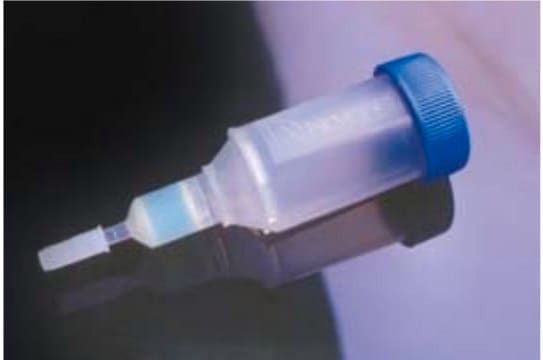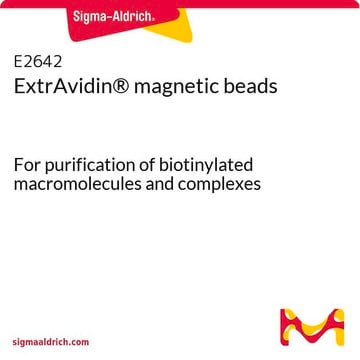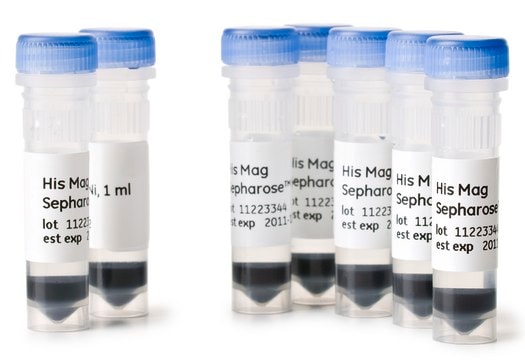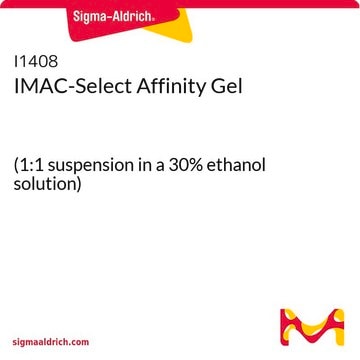H9914
HIS-Select® Nickel Magnetic Agarose Beads
Synonym(s):
nickel charged magnetic beaded agarose
Sign Into View Organizational & Contract Pricing
All Photos(1)
About This Item
UNSPSC Code:
41106500
NACRES:
NA.56
Recommended Products
conjugate
magnetic beads
form
suspension
shelf life
2 yr (Unopened product)
matrix
6% beaded magnetic agarose
capacity
≥15 mg/mL binding capacity
storage temp.
2-8°C
General description
HIS-Select Magnetic Agarose Beads consist of paramagnetic, immobilized metal-ion affinity chromatography (IMAC) resin that contain a proprietary quadridentate chelate, which is bound with nickel and covalently attached through a non-charged, hydrophilic linker to magnetic beaded agarose. The magnetic properties of the beads aid in manipulations, such as repetitive washings, and recovery of the protein bound beads. This leads to greater experimental reproducibility and more accurate quantitation of the His-tagged proteins of interest.
Application
The HIS-Select Nickel Magnetic Agarose Beads are designed for use in automated and small-scale affinity capture (molecular pull-down) purifications of histidine-tagged protein / His-tag protein while exhibiting low non-specific binding of other proteins. The beads can be used to purify His-tagged proteins under native and denaturing conditions.
Physical form
Supplied as a 50% slurry suspension in 30% Ethanol.
Legal Information
HIS-Select is a registered trademark of Merck KGaA, Darmstadt, Germany
related product
Product No.
Description
Pricing
Signal Word
Danger
Hazard Statements
Precautionary Statements
Hazard Classifications
Aquatic Chronic 3 - Carc. 1B - Flam. Liq. 3 - Repr. 1B - Skin Sens. 1 - STOT RE 2
Target Organs
Respiratory Tract
Storage Class Code
3 - Flammable liquids
WGK
WGK 3
Flash Point(F)
86.0 °F
Flash Point(C)
30 °C
Certificates of Analysis (COA)
Search for Certificates of Analysis (COA) by entering the products Lot/Batch Number. Lot and Batch Numbers can be found on a product’s label following the words ‘Lot’ or ‘Batch’.
Already Own This Product?
Find documentation for the products that you have recently purchased in the Document Library.
Customers Also Viewed
Sonja Hänzelmann et al.
Clinical epigenetics, 7, 19-19 (2015-03-13)
Primary cells enter replicative senescence after a limited number of cell divisions. This process needs to be considered in cell culture experiments, and it is particularly important for regenerative medicine. Replicative senescence is associated with reproducible changes in DNA methylation
Mei Suen Kong et al.
Science signaling, 12(567) (2019-02-07)
T cell activation is initiated by signaling molecules downstream of the T cell receptor (TCR) that are organized by adaptor proteins. CIN85 (Cbl-interacting protein of 85 kDa) is one such adaptor protein. Here, we showed that CIN85 limited T cell
Yun Wei et al.
Journal of materials chemistry. B, 1(15), 2066-2071 (2013-04-21)
The imidazolium cation was chosen as protein selective affinity group and a kind of ionic liquid magnetic microspheres was developed by immobilizing imidazolium cations onto the surface of silica-coated magnetic microspheres to form imidazolium ionic liquid modified magnetic microspheres (Fe3O4@SiO2@IL).
Joshua W Burgess et al.
American journal of respiratory cell and molecular biology, 41(6), 714-721 (2009-03-17)
Pneumocystis organisms are opportunistic fungal pathogens that cause significant pneumonia in immune-compromised hosts. Recent evidence has suggested that Pneumocystis carinii exists as separate mating types, and expresses and regulates proteins that govern meiosis and progression of the life cycle. This
Philip Vitorino et al.
Nature, 519(7544), 425-430 (2015-03-25)
Cell migration is a stepwise process that coordinates multiple molecular machineries. Using in vitro angiogenesis screens with short interfering RNA and chemical inhibitors, we define here a MAP4K4-moesin-talin-β1-integrin molecular pathway that promotes efficient plasma membrane retraction during endothelial cell migration.
Our team of scientists has experience in all areas of research including Life Science, Material Science, Chemical Synthesis, Chromatography, Analytical and many others.
Contact Technical Service












